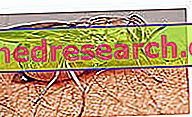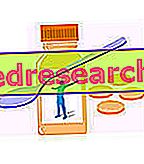Key points
Sleeping sickness (or African trypanosomiasis) is a parasitic infection transmitted to humans by the bite of an infected tsetse fly.
Causes
Sleeping sickness is caused by a flagellated protozoan parasite, Trypanosoma brucei :

- Trypanosoma brucei rhodesiense : etiological agent of East African trypanosomiasis (subacute sleep disease, which presents a violent and brief course)
- Tripanosoma brucei gambiens : causal agent of the Gambian African sleeping sickness (chronic trypanosomiasis)
Symptoms
- Hemolymphatic phase of sleeping sickness: joint pain, intermittent fever, swollen lymph nodes of the neck + anemia, cardiac and renal changes
- Neurological phase of sleeping sickness: mood alteration, anxiety, apathy, cachexia, inability to eat alone, uncontrollable lethargy, sweating
Diagnosis

Therapy
The therapy is purely antibiotic and must have started as soon as possible, starting from the onset of the very first symptoms.
Definition
African trypanosomiasis (TAU) - known to most as sleeping sickness - is a typical infection of the equatorial areas of Africa, caused by a parasite and transmitted to humans through the bite of tse-tse infected flies. Sleep sickness, which can affect humans and some animals without distinction, is a serious health problem, so much so that it ranks third after AIDS and severe diarrhea.
Sleeping sickness owes its curious name to the typical symptoms that occur after infection: lethargy, cachexia, apathy, inability to get up and feed on their own.
Incidence
Sleeping sickness is endemic in 36 or 37 countries in equatorial Africa. It is estimated that out of 60 million people who populate these areas, 50 / 70, 000 are annually infected.
African trypanosomiasis is a deadly disease: it is believed that, in 2008, 48, 000 people died after contracting the infection.
Four major epidemics have occurred in recent history:
- Epidemic in Uganda and the Congo basin in the years 1896-1906
- Epidemic in numerous African countries in 1920
- Epidemic in numerous African countries in 1970
- Uganda epidemic in 2008
In Africa, the risk of epidemics is still a reality: from this assumption the need arises to perfect and promote control and surveillance measures.
Unfortunately, sleeping sickness does not seem to capture the attention of the international community; as a result, African patients are still treated with old-generation drugs, which have significant side effects and are not very effective.
Causes and contagion
Sleeping sickness is caused by a parasitic infection sustained by Trypanosoma brucei (hence the name "tripanosomiasis"), a protozoan with a flagellum. The pathogen is transmitted to humans through the bite of infected tsetse flies.
There are two subspecies of Trypanosoma brucei :
- Trypanosoma brucei rhodesiense is responsible for the so-called "East African trypanosomiasis", the subacute form of the disease. The parasite is widespread in the eastern regions of Africa and is transmitted by the bite of the tsetse fly Glossina morsitans . This extremely virulent variant of the disease has a course that varies from a few days to a few months. As soon as the first symptoms appear, the victim is already in an advanced stage of the disease (involvement of the central nervous system) and, in the case of failed antibiotic intervention, the prognosis is negative.
- Tripanosoma brucei gambiense is responsible for the "African Gambia sleeping sickness", typical of West and Central African countries. It is estimated that this parasite is responsible for 90-95% of all forms of trypanosomiasis. The period of incubation of the protozoan can last for many years: during this period, the subject may also not show any appreciable symptoms. For this reason, the sleep sickness carried by T. brucei gambiense is called chronic trypanosomiasis . The aforementioned parasite is transmitted to humans by the tsetse fly Glossina palpalis .
The tsetse fly is contaminated by the protozoan after an infected subject is placed. Subsequently, the same fly transmits the parasite to a second individual (healthy) with its bite.
Sleep sickness can also be transmitted in different ways:
- Vertical transmission (mother-child)
- Sexual contact: trypanosomiasis is on the list of venereal diseases
- Transfusion of infected blood
- Handling of infected blood (nurses, researchers, doctors, etc.)

Symptoms
To learn more: Symptoms of sleeping sickness
The symptoms of sleeping sickness can be distinguished in two different phases.
- HEMOLINPHATIC PHASE (first stage): after contracting the infection, the patient complains of the following symptoms:
- Articolar pains
- Intermittent fever
- Swelling near the fly bite
- Enlarged (abnormal) lymph nodes in the neck
- itch
When left untreated, the clinical picture of sleeping sickness precipitates:
- Anemia
- Cardiac dysfunctions (eg myocarditis)
- Kidney dysfunctions
- NEUROLOGICAL PHASE: it begins when the parasite invades the central nervous system, going beyond the blood-brain barrier. The characteristic symptoms of this phase include:
- Mood changes
- Anxiety
- Apathy
- Cachexia
- Weakness
- Inability to get up and feed yourself
- Headache
- Uncontrollable sleepiness (hence the name "sleeping sickness")
- Sweating
In the absence of treatment, the disease is inevitably fatal: the victim has a progressive mental deterioration, followed by coma and death.
Curiosity
Tryptophol is a chemical compound capable of inducing sleep in humans. The same substance is synthesized naturally by the Trypanosoma brucei parasite.
Diagnosis
During the physical examination, a patient suffering from sleep sickness may show signs of inflammation of the brain and meninges (meningoencephalitis).
To ascertain a suspicion of trypanosomiasis it is necessary to perform targeted diagnostic tests:
- Blood smear
- Cephalorachidian fluid test (using rachicenthesis)
- Complete blood counting test
- Lymph node aspirates
Tests for the detection of antibodies are not very reliable in the context of sleeping sickness, since it is not possible to understand whether the infection is ongoing or whether it is a past infection.
Therapy
The choice of a treatment depends on the stage in which the disease is diagnosed. The drugs used for the treatment of haemolymphatic trypanosomiasis (stage 1) present a treatment profile of less toxicity and are rather simple to administer. These include:
- Pentamidine (intravenous or intramuscular): active ingredient generally well tolerated by patients. The drug is not active against infections supported by T. b. rhodesiense.
- Suramine (intravenously), involves side effects to the urinary tract and allergic reactions
The drugs used to treat the neurological phase of sleeping sickness have rather high toxicity.
The most used active ingredients are:
- Melarsoprol (arsenic derivative, to be taken intravenously) causes noticeable side effects, including reactive encephalopathy
- Eflornithine, active against TB gambiense
- Nifurtimox + Eflornithine: is not effective for Tb rhodesiense-supported infections.
Continue: Medications for the Treatment of Sleep Disease "
Prevention
The most effective weapon against sleeping sickness is prevention.
Two strategic lines have been devised:
- Reduction of the spread of the parasite: possible goal through monitoring, prophylaxis, treatment and surveillance
- Reduction in the number of tse-tse flies. The Pan-African Eradication Campaign for tsetse fly is currently being promoted to minimize the risk of contracting sleep sickness



